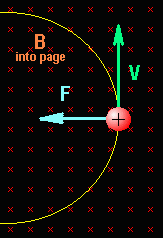Last modified: June 20, 1997
 In this demonstration particles are entering the region of the
magnetic field with their velocities being perpendicular to the
magnetic field lines. In such a situation the magnetic force serves to
move the particles in a circular path. According to the "right hand
rule" the magnetic force acting on the particle always remains
perpendicular to its velocity.
In this demonstration particles are entering the region of the
magnetic field with their velocities being perpendicular to the
magnetic field lines. In such a situation the magnetic force serves to
move the particles in a circular path. According to the "right hand
rule" the magnetic force acting on the particle always remains
perpendicular to its velocity.
The magnitude of the magnetic force is
This force can be also considered as the centripetal force
Making two above expressions equal to each other and solving the resulting equation for R we can easily find that the radius R of the circular path is proportional to the velocity of the particle.